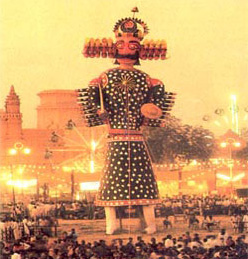|
One of the big festivals celebrated in most parts of
India is Dussehra. The festival is celebrated with zest
and festivities as it also marks the beginning of the
winter season after the long, unbearable, hot summer.
Dussehra marks the victory of Ram over the demon king
Ravana, and the rescue of his wife Sita. In north India,
gigantic effigies of the ten-headed Ravana and his
brothers are set aflame amidst bursting of crackers.
Fairs are usually held on this occasion with lots to
eat, buy and enjoy.
Dussehra means the Tenth Day, being the 10th day of the
bright half of Ashwin. This day is also known as
Vijayadashmi, or the Victory Tenth, because of the
victory of Ram over Ravana.

As Dussehra is preceded by the Navratri or the nine days
of the worship of Goddess Durga, some rituals related to
the Goddess are also carried out that day. The rituals
of Durga Puja involve the usual puja of goddess Durga
along with Lord Ram. On this day in Satyug, Ram (the
eighth incarnation of Lord Vishnu), killed the great
demon and king of Lanka, Ravan, who had abducted Ram's
wife Sita. Ram, along, with his brother Lakshman,
follower Hanuman, and an army of monkeys fought a great
battle for ten days to rescue his wife Sita.
According to another story, Kautsa, the young son of
Devdatt, a Brahmin, was living in the city of Paithan.
After studying under the guidance of Rishi Varatantu, he
insisted on his guru accepting a present, or
gurudakshina. Initially the guru refused but later asked
for 140 million gold coins, one hundred million for each
of the subjects taught. The obedient student went to the
King Raghu to ask for the money, as the king was
renowned for his generosity. Within three days the king
made the God of Wealth Kuber make a rain of gold coins
near the shanu and apati trees. After giving the
promised amount to the guru, Kautsa distributed the rest
of the coins among the needy on the day of Dussehra.
Even today, in Ayodhya, the capital of King Raghu,
people loot the leaves of the Apati trees and present to
each other as sona or gold.
Dussehra is one of the significant Hindu festivals,
celebrated with much joy and happiness in the entire
country. The occasion marks the triumph of Lord Ram over
Ravana, the victory of good over evil. Brilliantly
decorated tableaux and processions depicting various
episodes from Ram's life are taken out. On the tenth
day, or the Vijayadasami, colossal effigies of Ravana,
his brother Kumbhkarna and son Meghnad are placed in
vast open spaces. Actors dressed as Ram, his consort
Sita, and brother Lakshman arrive and shoot arrows of
fire at these effigies, which are stuffed with
firecrackers. The result is a deafening blast, and an
explosion of sound and light enhanced by the shouts of
merriment and triumph of the spectators.
Also part of the celebration is the Ram Lila or the
dramatic depiction of episodes from the lives of Ram,
Sita, and Lakshman. All the regions across the country
have evolved their own distinctive style, and
performances at different places are done in the local
language.
This was also the day to worship the weapons. According
to legend, Arjuna, one of the Pandav princes, hid his
weapons in a Shami tree when the Pandavs were banished
into the forests. After one year he returned from the
forest and on the day of Dussehra, he retrieved his
weapons and worshipped them along with the Shami tree.
Hence the custom of worshipping weapons on this day
started.
|